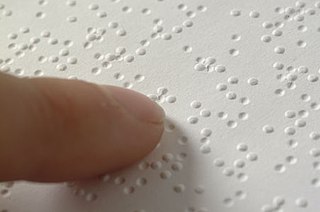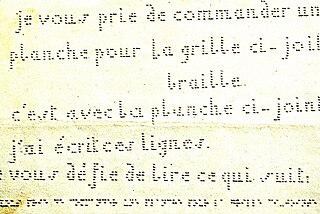
Braille is a tactile writing system used by people who are visually impaired, including people who are blind, deafblind or who have low vision. It can be read either on embossed paper or by using refreshable braille displays that connect to computers and smartphone devices. Braille can be written using a slate and stylus, a braille writer, an electronic braille notetaker or with the use of a computer connected to a braille embosser.

Louis Braille was a French educator and the inventor of a reading and writing system, named braille after him, intended for use by visually impaired people. His system is used worldwide and remains virtually unchanged to this day.

New York Point is a braille-like system of tactile writing for the blind invented by William Bell Wait (1839–1916), a teacher in the New York Institute for the Education of the Blind. The system used one to four pairs of points set side by side, each containing one or two dots. The most common letters are written with the fewest points, a strategy also employed by the competing American Braille.

9969 Braille, provisional designation 1992 KD, is an eccentric, rare-type and elongated asteroid from the innermost regions of the asteroid belt, classified as Mars-crosser and slow rotator, approximately 1–2 kilometers in diameter. It was discovered in 1992, by astronomers at Palomar Observatory and later named after Louis Braille, the inventor of the writing system for the blind. It was photographed in closeup by the spacecraft Deep Space 1 in 1999, but a malfunction resulted in indistinct images.
Night writing is the name given to a form of writing invented by Charles Barbier as one of a dozen forms of alternative writing presented in a book published in 1815: Essai sur Divers Procédés D'Expéditive Française, Contenant douze écritures différentes, avec une Planche pour chaque procédé. The term does not appear in the book, but was later applied to the method shown on Plate VII of that book. This method of writing with raised dots that could be read by touch was adopted at the Institution Royale des Jeune Aveugles in Paris.

The Perkins Brailler is a "braille typewriter" with a key corresponding to each of the six dots of the braille code, a space key, a backspace key, and a line space key. Like a manual typewriter, it has two side knobs to advance paper through the machine and a carriage return lever above the keys. The rollers that hold and advance the paper have grooves designed to avoid crushing the raised dots the brailler creates.

Braille music is a braille code that allows music to be notated using braille cells so music can be read by visually impaired musicians. The system was incepted by Louis Braille.
Unified English Braille Code is an English language Braille code standard, developed to permit representing the wide variety of literary and technical material in use in the English-speaking world today, in uniform fashion.

Japanese Braille is the braille script of the Japanese language. It is based on the original braille script, though the connection is tenuous. In Japanese it is known as tenji (点字), literally "dot characters". It transcribes Japanese more or less as it would be written in the hiragana or katakana syllabaries, without any provision for writing kanji.

Charles Barbier de la Serre was the inventor of several forms of shorthand and alternative means of writing, one of which became the inspiration for Braille.

Valentin Haüy was the founder, in 1785, of the first school for the blind, the Institute for Blind Youth in Paris. In 1819, Louis Braille entered this school.

A tactile alphabet is a system for writing material that the blind can read by touch. While currently the Braille system is the most popular and some materials have been prepared in Moon type, historically, many other tactile alphabets have existed:

The slate and stylus are tools used by blind people to write text that they can read without assistance. Invented by Charles Barbier as the tool for writing letters that could be read by touch, the slate and stylus allow for a quick, easy, convenient and constant method of making embossed printing for Braille character encoding. Prior methods of making raised printing for the blind required a movable type printing press.

Accessible publishing is an approach to publishing and book design whereby books and other texts are made available in alternative formats designed to aid or replace the reading process. It is particularly relevant for people who are blind, visually impaired or otherwise print disabled.

The American Printing House for the Blind (APH) is an American non-for-profit corporation in Louisville, Kentucky, promoting independent living for people who are blind and visually impaired. For over 150 years APH has created unique products and services to support all aspects of daily life without sight.

The Missouri School for the Blind (MSB) is a school for the blind and visually impaired in St. Louis, Missouri, operated by the State of Missouri. It has served the state of Missouri from the Greater St. Louis area for more than 150 years as a governmental agency of the state of Missouri. In 1860, the Missouri School became the first educational institution in the nation to adopt the braille system. It also owned, developed and operated one of the nation's earliest braille printing presses.
The goal of braille uniformity is to unify the braille alphabets of the world as much as possible, so that literacy in one braille alphabet readily transfers to another. Unification was first achieved by a convention of the International Congress on Work for the Blind in 1878, where it was decided to replace the mutually incompatible national conventions of the time with the French values of the basic Latin alphabet, both for languages that use Latin-based alphabets and, through their Latin equivalents, for languages that use other scripts. However, the unification did not address letters beyond these 26, leaving French and German Braille partially incompatible and as braille spread to new languages with new needs, national conventions again became disparate. A second round of unification was undertaken under the auspices of UNESCO in 1951, setting the foundation for international braille usage today.
Louis Braille's original publication, Procedure for Writing Words, Music, and Plainsong in Dots (1829), credits Barbier's night writing as being the basis for the braille script. It differed in a fundamental way from modern braille: It contained nine decades (series) of characters rather than the modern five, utilizing dashes as well as dots. Braille recognized, however, that the dashes were problematic, being difficult to distinguish from the dots in practice, and those characters were abandoned in the second edition of the book.

Decapoint, or raphigraphy, was a tactile form of the Latin script invented by Louis Braille as a system that could be used by both the blind and sighted. It was published in 1839. Letters retained their linear form, and so were legible without training to the sighted, but the lines were composed of embossed dots like those used in braille. Each letter contained ten dots in the height and different dots in the width to produce the graphic form of print.
World Braille Day is an international day on 4 January and celebrates awareness of the importance of braille as a means of communication in the full realization of the human rights for blind and visually impaired people. The date for the event was chosen by the United Nations General Assembly via a proclamation in November 2018, and marks the birthday of Louis Braille, creator of this writing system. The first World Braille Day was celebrated on January 4, 2019.














